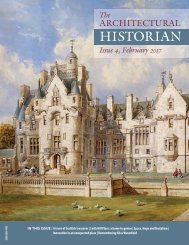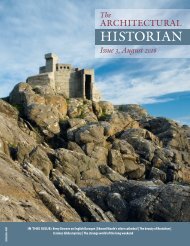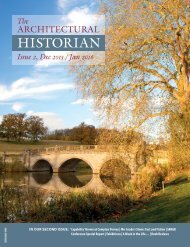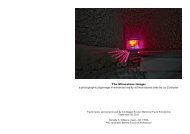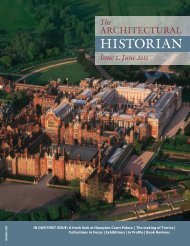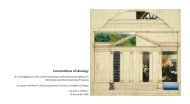100517_barge art catalog_FINAL
You also want an ePaper? Increase the reach of your titles
YUMPU automatically turns print PDFs into web optimized ePapers that Google loves.
‘Art Aboard!’<br />
The first season of<br />
The Elizabeth River Project<br />
LEARNING BARGE<br />
design . making . reflection . stewardship
Inspiration on the Elizabeth River<br />
The Elizabeth River is a key tidal estuary in<br />
the Chesapeake Bay Watershed. Centuries<br />
of heavy use, contaminants, and runoff have<br />
polluted the waters that were once home to a<br />
diverse ecosystem. Dedicated to remediation<br />
and preservation, The Elizabeth River Project<br />
took on the challenge of cleaning up the river<br />
through a grassroots movement and educational<br />
initiatives. While collaborating with The Elizabeth<br />
River Project on a restoration proposal for Money<br />
Point, Crisman + Petrus Architects noticed there<br />
was limited public access to the river and active<br />
restoration sites due to private and governmental<br />
ownership. Inspired by the proliferation <strong>barge</strong>s<br />
traveling along the working river, they envisioned a<br />
mobile environmental field station on a deck <strong>barge</strong>.<br />
Designed by students at the University of Virginia<br />
in collaboration with The Elizabeth River Project,<br />
a local naval designer, and regional school<br />
teachers, the LEARNING BARGE was built the<br />
summer of 2009 and launched in September<br />
2009. In addition to being an off-the-grid vessel<br />
with systems powered solely by the sun and<br />
wind, the BARGE is home to a rainwater filtration<br />
system, floating wetland, and a myriad of recycled,<br />
reclaimed, and ecologically friendly construction<br />
materials. As a demonstration tool and mobile<br />
field station, the BARGE traverses the<br />
important urban river that links Norfolk,<br />
Portsmouth, Chesapeake, and Virginia<br />
Beach. The BARGE will move to a new<br />
restoration site every few months, teaching<br />
p<strong>art</strong>icipants about the tidal estuary ecosystem,<br />
wetland and oyster restoration, sediment<br />
remediation efforts, and the significance of the<br />
Elizabeth River as a major port. It is expected that<br />
this fully accessible Coast Guard certified vessel<br />
will be visited by nearly 19,000 people a year.<br />
The core curriculum used on the vessel is aimed at<br />
grades K-12 and addresses issues of environmental<br />
stewardship through the lenses of science, history,<br />
sustainable design, and <strong>art</strong>. While on the BARGE,<br />
visitors of all ages learn how to help make the<br />
Elizabeth River swimmable and fishable by 2020.
Throughout the design, construction and<br />
implementation processes of the LEARNING<br />
BARGE, the Elizabeth River has served as a<br />
crucial source of creative impetus. Found objects,<br />
the color palette of industry and nature, and<br />
mixed typologies along the Elizabeth inspired<br />
works of <strong>art</strong> and fueled design decisions on<br />
the BARGE. Now, as a built object in its rich<br />
environment, the LEARNING BARGE serves<br />
as a community platform for visitors to find<br />
their own inspiration from the Elizabeth River.<br />
Students: Laura Bandara, Kimberly Barnett, Erin Binney, Matthew<br />
Bower, Neil Budzinski, Kacy Burnsed, Adam Burton, Mary Butcher,<br />
Alessandra Calaguire, Lauren Catlett, Allegra Churchill, Kate Claeys,<br />
Katie Clinton, Ama Cobbina, Sarah Collins, Taylor Cooper, Andrew<br />
Daley, Eliza Davis, Kevin Day, Lauren DiBianca, Adam Donovan, Erin<br />
Dorr, Matthew Dreher, Zoe Edgecomb, Ayman El-Barasi, Ben Fey,<br />
Dhara Goradia, Erin Hannegan, Ginny Harr, Hamin Hashime, Kristen<br />
Henderson, Mary Herbert, Liz Hoogheem, Andrea Hubbell, Ivy Hume,<br />
Matt Hural, April Johnson, Elissa Kauffman, Daniel Kim, Sarah Kott,<br />
Sarah Kunkel, Kate Lafsky, Phoebe Larson, Daphne Lasky, Shanti<br />
Levy, Hy M<strong>art</strong>in, Kelly McConnaha, Emily Miyares, Marylin Moedinger,<br />
Georgette Msambo, Anna Nau, Whitney Newton, Molly O’Donnell,<br />
Whitney Odell, Farhad Omar, Katherine Pabody, Su Park, Hadley<br />
Perona, Maressa Perreault, Graham Peterson, Kurt Petschke, James<br />
Pint, Laura Purvis, Anju Rathi, Jill Ringness, Rachael Robinson, Erin<br />
Root, Sarah Rosenthal, Ravi Sarpatwari, Tommy Schaperkotter,<br />
Robin Schick, Jamie Schw<strong>art</strong>zberg, Kristin Simpson, Rachel Singel,<br />
Jen Siomacco, Kate Spengel, Supriya Sudan, Ben Trudel, Clare Van<br />
Montfrans, Cara Warren, Nora White, Emily Williamson, Danielle<br />
Willkens, Courtney Wright, Edwin Wright, Clarice Zusky<br />
Faculty: Phoebe Crisman, Sanda Iliescu, Michael Petrus<br />
Images shown (top to bottom): Shanti Levi, Whitney Newton, Rachael Singel
Painting the BARGE<br />
Barges are common on the Elizabeth River, carrying<br />
goods, cranes, and serving as mobile housing units for the<br />
Navy. Typically, <strong>barge</strong>s are painted with simple lines and<br />
dark colors. Wanting to make the BARGE stand out in the<br />
landscape, student designers and faculty at the University<br />
of Virginia investigated a variety of inventive painting<br />
schemes. The schemes explored different color palettes,<br />
painting textures, and the incorporation of text. Students<br />
in Sanda Iliescu’s painting studio came up with four<br />
painting themes for the BARGE: Data, Poetry, Primary,<br />
and Sunny. The adjacent images represent the color<br />
scheme of the Sunny Barge. The use of two grey tones<br />
mirrored the color palette seen on many <strong>barge</strong>s and ships<br />
traversing the Elizabeth, but the incorporation of shades<br />
of yellow brightened the scheme and introduced a unique<br />
vibrancy to the vessel. The diagrammatic model for the<br />
Sunny Barge also used fields of color to call attention<br />
to built features onboard such as the Storytelling Stairs.<br />
The scheme blurred the boundaries between inside and<br />
outside and used color to differentiate the upper and<br />
lower decks. Although the Sunny Barge scheme was the<br />
initial inspiration for the BARGE’s final color palette, many<br />
aspects of the scheme were simplified due to the multiple<br />
layers of paint needed in the saline environment and<br />
complexity of cleanly painting edges around weld seams.<br />
The BARGE was uniformly painted with light grey; the<br />
accent color of orange was used for the bits and yellow<br />
was used for the cleats as well as the stripes that wrap<br />
from the bow to the longest filtration basin and the stern<br />
to the yellow steel bench of the RIVER Lab. The five barn<br />
doors along Green Alley were also painted with the yellow<br />
and grey palette; each door is adorned with a horizontal<br />
stripe representing a layer of the river’s ecosystem.<br />
Paintings: Liz Hoogheem (bottom two), Erin Hannegan (middle two)
BARGE Pillows<br />
In the Spring of 2009, Associate Professor of Architecture and Art Sanda Iliescu led a course on<br />
Painting and Public Art at the University of Virginia. Students in the course designed and fabircated<br />
cushions for the LEARNING BARGE. Although the BARGE is painted with light colors in order to<br />
reflect heat, the steel surface can still be very warm in the summer months. The cushions protect<br />
students from the hot surface and create a colorful field across the marine grey deck of the BARGE.<br />
Individually and in groups, the UVa students designed a number of 16” x 16” cushions, stuffed with a<br />
simple foam batting. Like the BARGE itself, many of the cushions were made from recycled materials,<br />
such as old jeans. Students explored various methods for sewing, folding, and weaving in order to<br />
create unique cushions with pockets, flaps, grommets, and ties. Each cushion can stand alone<br />
as a beautiful object or be connected to the others to create a brilliant quilt of comfort for visitors<br />
to the BARGE. In addition to individual ‘sit-upons’, two members of the LEARNING BARGE team<br />
from UVa made linear cushions for the RIVER Lab. Constructed of canvas and composed of the<br />
BARGE’s grey and yellow color scheme, the four cushions bring a soft surface to the classroom.<br />
Students: Lauren di Bianca, Ali Calaguire, Lauren Catlett, Kate Claeys, Kathleen Clinton, Dhara Goradia, Sarah Kott, Marylin<br />
Moedinger, Clare Von Montfrans, Maressa Perrault, Erin Root, Supriya Sudan
A New School<br />
The LEARNING BARGE represents a new approach<br />
to education. In a world of testing and ‘No Child<br />
Left Behind’, the BARGE realizes bold statements<br />
like the Chesapeake Bay Foundation’s credo, ‘No<br />
Child Left Indoors’. The BARGE takes students out<br />
of the classroom and into nature, allowing them<br />
to experience the watershed first hand. Through<br />
the BARGE’s unique design and adaptable<br />
curriculum, each learning station onboard highlights<br />
a key component of The Elizabeth River Project’s<br />
mission to make the river fishable and swimmable<br />
by 2020. Students learn how to clean up the<br />
Elizabeth and prevent pollution. Through drawing<br />
and making, students explore the beauty of the<br />
Elizabeth River. They are inspired and challenged<br />
to become caring stewards of our natural landscape.<br />
The mummichog, a small benthic fish, is the indicator<br />
species for The Elizabeth River. Since the mummichog<br />
does not migrate, the high cancer incidence of the<br />
fish has been directly linked to pollution in the river.<br />
Four sculptural mummichogs, made from aluminum,<br />
and recycled CDs and reclaimed bike reflectors,<br />
became the signature <strong>art</strong> pieces of the BARGE’s first<br />
operational season. Students added pieces of ribbon<br />
and recycled plastic to enliven each skeletal fish as a<br />
woven mosaic. As finished pieces, the fish embodied<br />
the collaborative spirit of the LEARNING BARGE and<br />
were put on display for the public at the dockside of<br />
the Elizabeth River Project’s office in Portsmouth, VA.
5<br />
4<br />
3<br />
The first operating season of the LEARNING<br />
BARGE welcomed a diverse range of students<br />
from grades 1-12. Each field trip welcomed<br />
approximately sixty students to the BARGE.<br />
Divided into groups of ten, they rotated through six<br />
stations. By engaging in hands-on activities and<br />
environmental stewardship actions that can be<br />
implemented at school or at home, students learn<br />
how to support the swimmable/fishable goal for 2020.<br />
1. FISHABLE River: students interact with<br />
creatures from the Elizabeth, like crabs, and learn<br />
how runoff is the number one source of pollution<br />
in the river. As a demonstration tool, the BARGE’s<br />
water system helps students understand the<br />
importance of the concept, ‘only rain down the drain’.<br />
2. RIVER Roots: while exploring the BARGE’s<br />
onboard wetland students learn how wetlands and<br />
oysters are natural filters that can help revive the<br />
Elizabeth River.<br />
3. RIVER Lab: inside the BARGE’s classroom<br />
students can explore ‘green’ materials and learn<br />
how chemicals, such as pesticides, affect the health<br />
of the river and lead to detrimental algae blooms.
6<br />
1<br />
2<br />
4. SWIMMABLE River: on the aft deck students<br />
discuss the importance of waste management, such<br />
as trash or pet waste, in relation to reducing bacteria<br />
levels and creating a healthy river.<br />
5. GREEN Alley: students learn how using<br />
sustainable technologies, such as the solar and<br />
wind power systems on the BARGE, can help<br />
conserve energy and reduce pollution.<br />
6. RIVER Art: students creatively express their<br />
experience with the Elizabeth River by drawing,<br />
painting, weaving, and writing. By using the river<br />
for <strong>art</strong>istic inspiration, students recognize the innate<br />
beauty of the unique natural and industrial landscape<br />
and learn to become conscientious river stewards.<br />
The following schools helped make the LEARNING<br />
BARGE’S first season a great success: Arrowhead<br />
Elementary, Butts Road Elementary, Chesapeake<br />
Montessori, Christ the King, Crestwood Intermediate,<br />
Faith Academy, Georgetown Primary, Independence<br />
Middle, Kemps Landing Magnet, Larchmont Elementary,<br />
Nansemond Suffolk Academy, Norfolk Academy, Norfolk<br />
Collegiate Lower School, Ocean View Maritime, Ruffner<br />
Middle, Southwestern Elementary, Tallwood High School,<br />
the Williams School.
River Wishes<br />
The <strong>art</strong> created onboard the LEARNING BARGE was intended to<br />
teach culture, foster expression, and encourage environmental<br />
responsibility. All of the <strong>art</strong>work produced onboard was ecofriendly:<br />
students used natural materials and certain pieces<br />
incorporated reclaimed and recycled items. Many of the projects<br />
featured in this <strong>catalog</strong> also stressed the collaborative aspect of<br />
restoration and remediation. Students worked on <strong>art</strong> pieces in<br />
small groups then displayed their work both on and off the BARGE<br />
to inspire citizens to learn more about the Elizabeth River and<br />
what they can do to help support the swimmable/fishable goals.<br />
At the conclusion of their field trips, many students made ‘river<br />
wishes’. These small cards were adorned with the messages<br />
and drawings from individual students, each containing a vision<br />
of a healthy Elizabeth River. With their wishes in hand, students<br />
walked across the yellow bridge of the onboard wetland, a<br />
design feature on the LEARNING BARGE that connects the<br />
RIVER Lab with the Storytelling Stairs just as the Elizabeth<br />
River forms a bridge between the cities of Norfolk, Portsmouth,<br />
Chesapeake, and Virginia Beach. Once across the bridge,<br />
made from reclaimed grating, the students’ wishes were floated<br />
in clear boxes in the seining pool of the onboard wetland.<br />
The pool on the BARGE preforms a variety of operational,<br />
educational, and <strong>art</strong>istic functions. The pool is the only place on<br />
the BARGE where the collected rainwater and brackish water<br />
pumped from the river mix. Oysters and small creatures from<br />
the river often find a temporary home in the micro ecosystem of<br />
the pool. At the end of each field trip students gather at the bright<br />
Storytelling Stairs to share their experiences and observations<br />
on the BARGE. As p<strong>art</strong> of the closing ‘ceremony’ to every<br />
BARGE field trip, students parade off the BARGE carrying items<br />
representing cultural traditions from global celebrations of water.
Sp<strong>art</strong>ina Tapestries<br />
Wetlands are natural buffers for coastlines. Like many other<br />
tidal areas, development and boating have depleted the<br />
wetland grasses of the Elizabeth River. Without grasses<br />
like Sp<strong>art</strong>ina, the coastlines are more susceptible to erosion<br />
and the ecosystem are thrown off balance. The Elizabeth<br />
River project is dedicated to restoring the wetlands.<br />
The BARGE has a wetland onboard so that visitors can<br />
see how Sp<strong>art</strong>ina and other native grasses act as water<br />
filtration systems. Many students who visit the BARGE<br />
grow Sp<strong>art</strong>ina in their classrooms as p<strong>art</strong> of the “Wetland in<br />
the Classroom” project by the Dollar Tree Foundation and<br />
plant the grasses at Elizabeth River wetland restoration<br />
sites. In addition, The Elizabeth River Project’s River<br />
Star Schools initiative annually recognizes schools for<br />
conservation, restoration, and habitat enhancement<br />
projects. There are over 200 public and private schools in<br />
the watershed and currently 114 are River Star Schools.<br />
While on the BARGE, students abstracted their observation<br />
of the Elizabeth’s wetlands by using organic thread on<br />
burlap to create inventive Sp<strong>art</strong>ina tapestries. These<br />
large <strong>art</strong> pieces were then taken back to the classroom<br />
to be displayed, serving as a reminder of their time<br />
on the BARGE and the importance of the wetlands.
Temporary Art<br />
Student visitors to the BARGE used large canvases, painted<br />
by UVa student designers with abstract watercolor scenes of<br />
the Elizabeth River, as background to create temporary <strong>art</strong>.<br />
Students used river rocks to create imagined landscapes<br />
and ecosystems. The rocks also inspired discussions about<br />
runoff and filtration techniques. Their creations were then<br />
photographed and used to illustrate narratives of the Elizabeth<br />
and its future. A large component of <strong>art</strong> aboard the BARGE<br />
was challenging students to explore the contemporary<br />
landscap,e but also envision a future of healthy eco-operations.<br />
Picturing the BARGE<br />
The LEARNING BARGE is a unique vessel on the Elizabeth<br />
River that uses design to mix technology and environmentalism.<br />
Students were given the opportunity to draw their interpretation<br />
of the BARGE while onboard, using chalk and recycled<br />
construction paper. Their drawings were displayed dockside for<br />
public view and gave a sense of individual experience: some<br />
students drew elements of the ‘green’ systems such as the wind<br />
turbines onboard while others focused on plants or structure.
Native Techniques<br />
The Elizabeth River was named in the early 1600s<br />
for the daughter of King James the I of England,<br />
but the first residents along the shores were not<br />
European. The Chisapeack tribe lived along<br />
the river and called it the Chisapeake, which<br />
meant the ‘plentiful shellfish and Mother Waters’.<br />
In a historiographic creative exercise, students<br />
divested themselves of modern cutting tools<br />
and used techniques similar to the Native<br />
Americans that once called the river home.<br />
Students tore scraps of tissue paper by hand<br />
into representations of the mummichog. The fish<br />
were then collaged on paper canvases to create<br />
colorful and diverse schools of fish. The once<br />
large and vibrant fish population of the Elizabeth<br />
River has decreased drastically since the time<br />
of the Chisapeack tribe. Fertilizers and other<br />
pollutants have led to algae blooms on the water’s<br />
surface, essentially suffocating the fish below.<br />
Monitoring runoff and engaging in proper disposal<br />
methods can help revive the fish of the Elizabeth.
Testing the Waters<br />
The Elizabeth River is home to many crabs; however,<br />
few students have interaction with these curious<br />
creatures. Collection boxes and habitat cubes are<br />
pulled out of the water near the bow of the BARGE,<br />
attracting various river organisms. During field trips to<br />
the BARGE, these boxes and bags are pulled out of<br />
the water and onto the deck giving students the chance<br />
to interact with the creatures living in the river’s murky<br />
waters. Inspired by the crabs, students visiting the<br />
BARGE used harvested rain water and watercolors<br />
to paint images of the Elizabeth River’s own army of<br />
decapod crustaceans. Painted on recycled paper,<br />
students drew crabs from live images and imagined<br />
creatures in vibrant hypercolor. Once a prevalent<br />
species in the Chesapeake Bay watershed, the health<br />
of the crabs, much like the health of the adjacent waters,<br />
has been in decline. The crab paintings were displayed<br />
on the dock-side of the BARGE for a period of time<br />
before they were sent as thank you notes to p<strong>art</strong>icipants<br />
in the Elizabeth River Project’s programs and donors.<br />
The ‘eco’ watercolor technique was also used by students<br />
onboard to create a varied school of fish, featured in the<br />
following pages. In this <strong>catalog</strong>, water and air are united<br />
since watercolored mummichogs ‘swim’ among brown<br />
pipe cleaners that were used to make interpretations<br />
of osprey nests. Students presented their work to<br />
each other onboard and took their creations home as<br />
reminders of their time on the LEARNING BARGE.
Reflections on the First Season<br />
While on the LEARNING BARGE, students<br />
learn how small, environmentally conscious acts<br />
around their homes and schools can make big<br />
impacts on the ecosystem of their home river.<br />
Many of the younger visitors to the BARGE<br />
imagined and drew ‘River Heroes’ on pieces of<br />
organic canvas. The individual pieces were affixed<br />
together to make a large patchwork quilt, such as the<br />
segment featured on the left. Although Mummichog<br />
Girl and Captain Recycle are inspirational stewards,<br />
the true heroes are the residents and friends of<br />
the Elizabeth River that do their p<strong>art</strong> everyday<br />
to clean and preserve the delicate ecosystem.
Art Aboard and this booklet were made possible by a 2009 Access to Artistic<br />
Excellence I Grant from the National Endowment for the Arts. The grant also supported the<br />
work of The Elizabeth River Project’s lead BARGE Educator, Robin Dunbar, and Designerin-Residence,<br />
Danielle Willkens. All of the work featured in this booklet was produced by<br />
students, specifically for or on the LEARNING BARGE. © The Elizabeth River Project, 2010<br />
For more information on the LEARNING BARGE and Art Aboard go to:<br />
www.elizabethriver.org<br />
The Learning Barge was made possible with the generous support of the following contributors and p<strong>art</strong>ners:<br />
Crisman + Petrus Architects<br />
East Coast Steel Fabrication, Inc.<br />
Matherne Marine Design<br />
Luck Stone Corporation<br />
Altenergy<br />
Appalachian Sustainable Development<br />
BAE Systems<br />
Beazley Foundation<br />
Biohabitats<br />
Bliss-Nor Am<br />
Blue Sea Systems<br />
BWI Distribution<br />
Canal Barge<br />
Charlottesville Glass & Mirror<br />
Chesapeake Bay Foundation<br />
Coenergy, Inc.<br />
Creasy & Whiteed<br />
Crofton Diving<br />
John & Lynn Daley<br />
Distribution International<br />
Dollar Tree Foundation<br />
DTI Solar<br />
Envirolet<br />
The Norfolk Foundation<br />
Norfolk Southern Foundation<br />
PPG Industries<br />
Richard & Marie Knowles<br />
S. Michael Evans<br />
Hampton University<br />
Hanbury Evan Wright Vilatas Co.<br />
HRSD<br />
Ireland Marine, Inc.<br />
Kinder Morgan/Elizabeth River Terminals<br />
Moler & Assoc.<br />
Frank & Jane Munoz<br />
Nansemond-Suffolk Academy<br />
National Roofing Corp.<br />
Nature Neutral<br />
NCARB Prize<br />
Norfolk Academy<br />
Orion Safety<br />
Oyster Reef Keepers<br />
P<strong>art</strong>nership Foundation<br />
Perko Marine Supplies<br />
Piedmont Plastics<br />
Phocos<br />
Skanska<br />
US EPA<br />
Virginia Environmental Endowment<br />
Anonymous donors<br />
PODS<br />
Portsmouth Community Foundation<br />
Portsmouth General Hospital Foundation<br />
Reliance Concrete<br />
Renaissance Portsmouth Hotel<br />
Rivanna Conservation Society<br />
Robbins Maritime, Inc.<br />
Mathhew L. Richardson<br />
SecoSouth<br />
Skyline Turbine Charlottesville<br />
Solar Panels Plus<br />
Sandra & William Spengel<br />
Walker & Leberge<br />
Warren Claytor Architects<br />
Waterway Recycling<br />
West Marine<br />
Dan & Candace Willkens<br />
Yacht Systems Services, Inc.<br />
YCOSST




